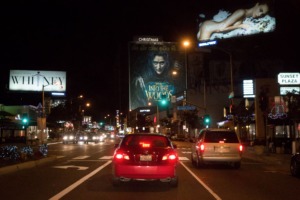
Room after room, turn after turn, Wolfgang Tillmans’ Tate Modern exhibition teems with images large and small. Images alone and arrays of larger and smaller photographs, framed and unframed and attached to the wall with bulldog clips, hung high over doorways and shuffled on a table.
A young man’s neck, a knee, a hand stuffed down a pair of shorts. A glimpse of flesh as someone turns. A boy looking at his phone at a London roundabout, a young man in Jeddah, Saudi Arabia, all in fuchsia next to his shiny purple car, mobile phone in his hand. A pair of balls and anus, close-up, huge on the wall. A city seen from the sky from an aeroplane window; another city, veiled in pollution. You can get very close or not nearly close enough. Or even too close.
These shifts in distance and proximity, scale and presentation let Tillmans’ photographs, in all their variety, breathe. Such stratagems are familiar from earlier exhibitions of the German artist’s work, but are more than just a way of amassing his material. They take account of our mobility and insatiable hunger for the next thing, in order to slow us down and pay attention.
